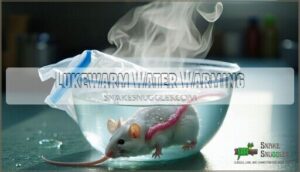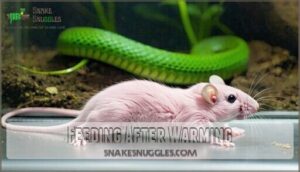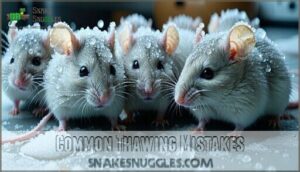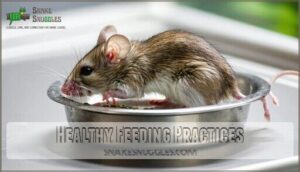This site is supported by our readers. We may earn a commission, at no cost to you, if you purchase through links.
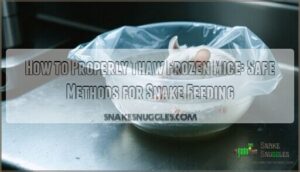 You’ll thaw frozen mice safely by placing them in your refrigerator overnight or submerging them in cold water for faster results.
You’ll thaw frozen mice safely by placing them in your refrigerator overnight or submerging them in cold water for faster results.
Never use a microwave – it creates hot spots that can burn your snake’s mouth and destroys nutrients.
Place mice in sealed bags to prevent contamination, just like you’d handle raw chicken.
Cold water thawing takes 30-60 minutes depending on size.
Once thawed, warm the mouse in lukewarm water before feeding.
Check for any funky smells or slimy texture that signals spoilage.
The key is patience – rushing the process puts your scaly friend at risk and wastes perfectly good prey.
It is critical to follow these steps to ensure the health and safety of your pet.
Table Of Contents
Key Takeaways
- Use cold methods only – Thaw frozen mice in your refrigerator overnight or submerge them in cold water for 30-60 minutes, never use a microwave as it creates dangerous hot spots that can burn your snake’s mouth.
- Keep everything sealed and clean – Place mice in sealed bags during thawing to prevent contamination, use dedicated containers separate from human food, and wear disposable gloves when handling.
- Warm before feeding – After thawing, warm the mouse in lukewarm water (100-105°F) for 10-20 minutes to mimic natural prey temperature and aid your snake’s digestion.
- Watch for spoilage signs – Trust your nose for foul smells, check for slimy texture or discoloration, and feed within 24 hours of thawing since bacteria multiply rapidly at room temperature.
Safe Thawing Methods
When it’s time to feed your snake, you’ll need to safely thaw those frozen mice without turning them into a science experiment gone wrong.
The right thawing method protects both your pet’s health and your kitchen from unwanted bacteria parties.
Smart thawing keeps your snake healthy and your kitchen bacteria-free.
Refrigerator Thawing Techniques
Why wait hours when refrigerator thawing delivers the safest results? This slow thawing method prevents bacterial growth while preserving your snake’s meal perfectly.
Though it takes patience, overnight defrosting guarantees nutritional preservation that your reptile deserves. Considering safe rodent products can help guarantee a healthy meal for your snake.
Here’s your refrigerator thawing roadmap:
- Place frozen rodents in sealed bags – prevents contamination and moisture loss
- Set temperature between 35-40°F – maintains safe refrigeration zone for gradual thawing
- Allow 4-5 hours for rats, 2 hours for mice – timing varies by prey size
- Keep separate from human food – use designated container for safe thawing techniques
- Check progress periodically – guarantees complete thaw before warming phase
Cold Water Thawing Procedures
Cold water thawing offers a faster alternative when you’re pressed for time.
Submerge your bagged frozen rodents in cold water for 30 minutes, changing the water every 15 minutes to maintain proper water temperature. This bagged submersion method guarantees even thawing throughout the mouse’s body.
You can also find prey item options online. The consistent thawing duration and regular water changes prevent bacterial growth while delivering safe thawing techniques for your snake’s next meal.
Thawing in Sealed Bags
Place your frozen mouse in a sealed plastic bag before submerging it in cold water. This bag material prevents water from seeping in, ensuring even thawing while maintaining the mouse’s texture and nutritional value.
The bagged submersion method eliminates water displacement issues and supports proper thawing methods. To further improve palatability, consider adding lizard body scent to the thawed prey.
Change the water every fifteen minutes for best thawing practices and ideal thawing safety when preparing rodents, using the bagged submersion method.
Thawing Frozen Mice Properly
Your snake’s nutritional needs depend on getting the thawing process just right.
Thawing Duration varies substantially by Mouse Size—mice need about 2 hours in the refrigerator, while larger rats require 4-5 hours for complete defrosting.
The cold water method works faster, taking roughly 30 minutes for mice with water changes every 15 minutes.
Water Temperature matters more than you’d think—stick to cold water during the initial thawing phase to prevent bacterial growth.
Different Reptile Species have varying preferences, but proper thawing methods remain consistent across the board.
Thawing Frequency should match your feeding schedule, only defrosting what you’ll use immediately.
Best thawing practices involve using sealed bags to prevent contamination while ensuring even temperature distribution.
Safe thawing methods protect both you and your reptile from harmful bacteria that multiply rapidly at room temperature.
Warming Thawed Mice
Once you’ve thawed your frozen mouse, you’ll need to warm it to mimic natural prey temperature before feeding.
This warming step guarantees your snake can digest properly and reduces the risk of regurgitation or digestive issues.
Lukewarm Water Warming
Once you’ve properly thawed your frozen rodent, warming becomes the next critical step.
Lukewarm water between 100-105°F creates the temperature that mimics natural prey warmth. You’ll want to maintain proper bagged warming techniques to prevent bacterial growth while guaranteeing your snake receives appropriately heated food.
Here’s your lukewarm water warming checklist:
- Heat water to 100-105°F – Hot enough to warm through, cool enough to preserve nutrients
- Submerge bagged rodent for 10-20 minutes – This warming duration ensures even heat distribution
- Check water quality remains clean – Fresh water prevents contamination during the process
- Handle with care during post-warming handling – Your snake deserves properly prepared prey
Feeding After Warming
Once you’ve warmed your thawed mouse, timing becomes your best friend for successful snake feeding.
You’ll want to offer the prey immediately after warming to maintain prime prey temperature and maximize reptile acceptance.
This quick shift from warming thawed mice to feeding guarantees your snake gets the nutritional benefits while minimizing digestion concerns and bacterial growth risks.
Remember that internal organs decay rapidly after thawing.
Preventing Decay and Bacterial Growth
Time’s your friend when preventing bacterial growth and decay.
You’ve got roughly 24 hours after thawing to feed your snake before harmful bacteria multiply like crazy.
Keep thawed mice refrigerated until feeding time, and trust your nose—spoiled mice smell awful.
Never refreeze thawed rodents; refreezing risks create perfect breeding grounds for dangerous bacteria that’ll make your snake sick, as it can lead to harmful bacteria multiplication, and ultimately cause your snake to get sick.
Common Thawing Mistakes
Even experienced snake owners make thawing mistakes that can harm their pets or create health risks.
You’ll want to avoid these common errors to keep both you and your snake safe during feeding time.
Avoiding Microwave Thawing
Microwaves aren’t your friend when thawing frozen mice for your snake.
Here’s why you should skip this shortcut:
- Uneven heating creates hot spots that can burn your snake’s mouth
- Contamination risks spread bacteria throughout your kitchen appliances
- Exploding organs make a mess and reduce nutritional value
These safety concerns make microwave thawing a recipe for disaster.
Preventing Cross-Contamination
During thawing, you’ll want dedicated containers exclusively for snake food—never mix with human dishes.
Always wear disposable gloves when handling frozen mice, and disinfect all tools afterward to prevent bacterial contamination.
Clean surfaces thoroughly between uses, because proper handling and hygiene practices protect both you and your snake from crosscontamination risks that could compromise food safety and require proper handling.
Recognizing Spoiled Mice
Spoiled mice pose serious health risks to your snake, so you’ll need to spot warning signs quickly.
Look for odor indicators like foul, sour smells or ammonia scents that signal bacterial contamination.
Visual signs include discoloration risks such as yellow, green, or gray patches, plus dull eyes or visible mold colonies.
Texture changes like slimy skin or mushy muscle tissue indicate spoilage prevention failed, while feeding refusal from your snake often means spoilage risks.
Remember that bacteria can proliferate after thawing.
Healthy Feeding Practices
When you follow proper thawing techniques, you’ll preserve the nutritional value your snake needs while preventing dangerous digestive problems.
The key lies in maintaining safe temperatures and clean handling practices that protect both your pet’s health and your own safety.
Preserving Nutritional Value
Proper thawing methods preserve nutritional integrity by maintaining stable temperatures throughout the process. Gradual thawing at consistent cold temperatures prevents cell rupture and retains up to 98% of original nutrients, while rapid thawing can destroy essential vitamins.
One advantage is the lower parasite transmission when feeding frozen prey.
- Refrigerator thawing maintains ideal vitamin retention and fatty acids
- Cold water methods preserve protein content when using sealed bags
- Avoiding temperature spikes prevents nutrient loss during frozen mice thawing
Reducing Risk of Digestive Issues
Smart feeding prevents digestive disasters.
**Your snake’s health starts with proper thawing—no shortcuts, no regrets.
You’ll reduce regurgitation risk by confirming complete thawing and proper warming temperatures.
Thawing frozen rodents at controlled temperatures prevents bacterial overgrowth that causes intestinal upset.
| Risk Factor | Prevention Method |
|---|---|
| Bacterial Growth | Maintain thawing temperature below 10°C |
| Impaction | Confirm complete thawing before feeding |
| Regurgitation | Use proper warming techniques |
| Thermal Shock | Feed at room temperature |
| Digestive Upset | Practice safe handling throughout |
Maintaining Hygiene and Safety
Always wear disposable gloves when handling thawing frozen rodents to prevent bacterial concerns and maintain safe thawing practices.
Use designated containers exclusively for frozen mice care and disinfect all tools after use to avoid cross-contamination.
Proper handling includes using hygienic hand protection to minimize risks.
This simple approach to safe handling protects both you and your snake from potential health risks during frozen rodent handling, ensuring a healthy environment.
Frequently Asked Questions (FAQs)
How long can thawed mice sit out safely?
You shouldn’t leave thawed mice sitting out for more than 30 minutes at room temperature.
After that, bacterial growth kicks in, making them unsafe for your snake and potentially causing digestive issues or illness.
Can you thaw multiple mice sizes together?
One size doesn’t fit all—you can thaw different mouse sizes together, but they’ll finish at different times.
Smaller mice thaw faster than larger ones, so check each size separately and remove them as they’re ready.
What temperature should storage freezer be set?
Your freezer should be set at or below 0°F (-18°C) to properly store frozen mice.
This temperature keeps them safe and maintains their nutritional quality for up to six months without spoilage or freezer burn.
How do you know when mouse completely thawed?
Surprisingly, 90% of reptile feeding issues stem from improperly thawed prey.
You’ll know your mouse is completely thawed when it’s soft throughout, flexible at joints, and feels room temperature to touch—no frozen spots remain, which is a key indicator of a properly thawed mouse.
Can you use tap water for thawing?
Yes, you can use tap water for thawing frozen mice.
Cold tap water works perfectly fine – just change it every fifteen minutes to keep the temperature consistent and guarantee even thawing throughout the mouse’s body, which is a critical step to ensure proper thawing.
Conclusion
Nearly 80% of snake feeding problems stem from improper thawing techniques, yet most owners don’t realize they’re making critical mistakes.
Mastering how to properly thaw frozen mice isn’t rocket science, but it requires patience and the right approach.
You’ve learned that refrigerator thawing overnight and cold water methods keep your snake healthy, while microwaving creates dangerous hot spots.
Remember to use sealed bags, warm in lukewarm water before feeding, and trust your nose to detect spoilage.
Following these simple steps protects your scaly friend and saves money.

